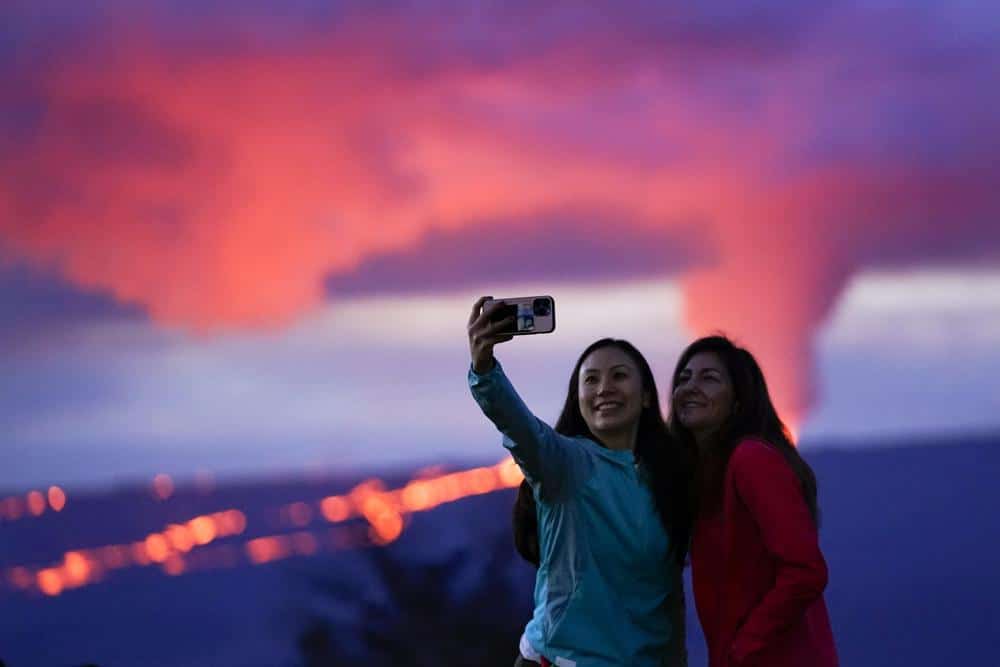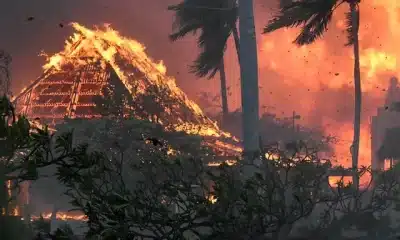News
Thousands in Hawaii Flock to Watch Lava Ooze from Volcano

The world’s largest volcano in Hawaii erupted with rivers of glowing lava on Wednesday, attracting thousands of awestruck onlookers who clogged a highway that the flow could soon bury.
Mauna Loa awoke from its 38-year slumber on Sunday, sending volcanic ash and debris into the sky. A major highway connecting towns on the Big Island’s east and west coasts became an impromptu viewing point, with thousands of cars jamming the highway near Volcanoes National Park.
Anne Andersen left her overnight shift as a nurse on Wednesday to witness the spectacle, fearing that the road would soon be closed.
“It’s Mother Nature showing us her face,” she said as the horizon was filled with gas from the volcano. “It’s quite exciting.”
Gordon Brown, a visitor from Loomis, California, could see the bright orange lava from his rental house’s bedroom. So he went out with his wife to get a better look.
“We just wanted to get as close to this as possible.” “And it’s so bright that it blows my mind,” Brown explained.
The lava was tumbling down the slope slowly and was about 6 miles (10 kilometers) from the Saddle Road highway. It was unclear when or if the road, which runs through old lava flows, would be covered.
The road cuts the island in half and connects Hilo and Kailua-Kona. If Saddle Road becomes impassable, people traveling between them would have to take a longer coastal road, adding several hours to their drive time.
According to Ken Hon, chief scientist at the Hawaiian Volcano Observatory, at the current flow rate, the lava could reach the road in two days, but it will most likely take longer.
“As the lava flow spreads out, it will most likely obstruct its progress,” Hon predicted.
Kathryn Tarananda, 66, of Waimea, set two alarms to ensure she didn’t oversleep and miss the sunrise against Mauna Loa’s eruptions.
“It’s exciting,” she said. “We’re in the middle of nowhere. Incredibly, we live in this place. “I consider myself extremely fortunate to be an islander.”
Mauna Loa erupted last in 1984. The current eruption is the 34th recorded since written records began in 1843. Because Kilauea, its smaller neighbor, has been erupting since September 2021, visitors to the national park were treated to the rare sight of two concurrent eruptive events: the glow from Kilauea’s lava lake and lava from a Mauna Loa fissure.
The natural forces on display impressed Abel Brown, a visitor from Las Vegas. Later in the day, he intended to take a close-up helicopter tour — but not too close.
“If you get close to it, there’s a lot of fear and trepidation,” Brown said. “The closer you get, the more powerful and frightening it becomes.”
Officials were initially concerned that lava flowing down Mauna Loa would threaten the South Kona community, but scientists later assured the public that the eruption had migrated to a rift zone on the volcano’s northeast flank and was no longer a threat.
Along Saddle Road, where people were watching the wide stream of lava creep closer, the smell of volcanic gases and sulfur was strong.
Gov. David Ige issued an emergency proclamation to allow responders to arrive quickly and, if necessary, to limit access.
Ige, who has dealt with numerous volcano eruptions during his eight years as governor, believes it is impossible to divert Mauna Loa’s molten rock away from the highway.
“There is no physical or technological way to change the path of the lava,” Ige said at a press conference. He recalls wishing he could do that in 2018 when Kilauea erupted and poured lava across homes, farms, and roads.
“But, as we saw in that event, Mother Nature’s and Madam Pele’s power overwhelms anything we can do,” Ige said, referring to the Hawaiian deity of volcanoes and fire.
Ige stated that if lava does cross the highway, the Hawaii National Guard could assist in planning alternatives and attempting to establish bypass routes.
According to Hon, lava crossed the Mauna Loa Observatory access road Monday night and cut power to the facility. It is the world’s most advanced station for measuring heat-trapping atmospheric carbon dioxide.
The federal government is looking for a temporary alternate location on the Hawaiian island and is considering flying a generator to the observatory to restore power so that measurements can be taken again.
Meanwhile, scientists are attempting to quantify the gas emitted by the eruption.
News
Katie Ledecky Hopes For Clean Races At Paris Olympics In The Aftermath Of The Chinese Doping Scandal

PARIS — Katie Ledecky is looking for clean Olympic races. On Wednesday, Hope had pretty much reached her limit.
The American swimmer hopes to add to her six gold medals as she competes in the 400, 800, and 1,500 meters at the Paris Games. Her program starts with the heavy 400 on Saturday, featuring Ariarne Titmus and Summer McIntosh.

Katie Ledecky | ESPN Image
Katie Ledecky Hopes For Clean Races At Paris Olympics In The Aftermath Of The Chinese Doping Scandal
The 27-year-old Katie is competing in her fourth Summer Olympics, but the first since a doping scandal involving almost two dozen Chinese swimmers who tested positive for a banned chemical before the Tokyo Games — yet were permitted to compete with no consequences. The controversy has raised serious worries regarding the effectiveness of anti-doping initiatives.

Katie Ledecky | Vogue Image
“I hope everyone here is going to be competing clean this week,” Ledecky claimed. “But what truly counts is, were they training cleanly? Hopefully this has been the case. Hopefully, there has been worldwide testing.”
The International Olympic Committee has expressed concern over the ongoing US investigation into possible doping by Chinese swimmers. While awarding the 2034 Winter Olympics to Salt Lake City on Wednesday, the IOC urged Utah officials to do whatever they could to stop the FBI investigation.
“I think everyone’s heard what the athletes think,” Katie added. “They seek transparency. They want more answers to the remaining questions. At this point, we are here to race. We are going to race whoever is in the lane next to us.
“We are not paid to conduct the tests, so we trust those who follow their regulations. That applies both today and in the future.

Katie Ledecky | ESPN Image
Katie Ledecky Hopes For Clean Races At Paris Olympics In The Aftermath Of The Chinese Doping Scandal
SOURCE | AP
News
London Heatwave Alert: High Temperatures Set to Soar to 29C Next Week

As the summer holidays begin, London may experience an official heatwave with temperatures reaching up to 29 degrees Celsius.
The Met Office predicts a long period of sunny and dry weather for London after a soggy spring and summer.
After a cloudy day on Saturday, temperatures are expected to reach 27C on Sunday, with lots of sunlight.
On Monday and Tuesday, temperatures are forecast to peak at 29 degrees Celsius. Monday is forecast to offer more sunlight, while Tuesday may see some gloomy weather.
Temperatures are expected to remain in the high 20s next week, with lows of approximately 18C.
According to the Met Office, a heatwave is “an extended period of hot weather relative to the expected conditions of the area at that time of year, which may be accompanied by high humidity.”
In the United Kingdom, a heatwave is proclaimed when daily temperatures meet or surpass a certain level for at least three consecutive days.
In London, the heatwave threshold is 28 degrees Celsius.
The Met Office reported that the UK is experiencing hotter and wetter weather on average due to climate change.
The UK experienced its warmest May and April on record this year, despite damp and dismal conditions in many areas.
According to the Met Office’s State Of The UK Climate 2023 report published on Thursday, the UK experienced historic levels of extreme weather last year.
In the United Kingdom, 2023 was the second warmest year on record, bringing storms, flooding, strong heatwaves, and rising sea levels; only 2022 was warmer.
It was 0.8°C higher than the average from 1991 to 2020, and 1.66°C higher than the 1961 to 1990 average.
However, 2023 will be a “cool year” in comparison to 2100, based on the planet’s warming trajectory.
The government’s plan to adapt to the hazards presented by climate change is currently being challenged in the High Court by campaigners who allege the Tory administration’s July 2023 National Adaptation Programme (NAP) fails to adequately address 61 concerns.
Source: The Standard
News
Novo Nordisk’s Wegovy is a Heart-Risk-Reducing Product.

(VOR News) – The European Union’s medical regulator has granted approval to Wegovy, a blockbuster weight loss treatment manufactured by Novo Nordisk, in order to expand its application to include the reduction of major heart events in overweight or obese adults.
In order to expand the scope of the medication’s applicability, this authorisation was granted. The purpose of obtaining this approval was to broaden the medicine’s application.
The Danish pharmaceutical company announced on Thursday that the European Medical Agency has formulated a “positive opinion” regarding the label’s expansion.
The agency made this determination after conducting a comprehensive examination of the results of a SELECT study that was subjected to rigorous monitoring. Other applications of the substance are facilitated by this conclusion.
The SELECT experiment, which was financed by Novo Nordisk and published in August 2023.
Wegovy and Ozempic contain semaglutide as the active ingredient.
Reduced the risk of major cardiovascular events by twenty percent when compared to a placebo. The researchers arrived at this conclusion. This realisation was the outcome of the researchers’ investigation.
The notion that the European Medicines Agency label for Wegovy should be amended is a significant step forward for patients who are coping with cardiovascular disease and obesity, according to Martin Holst Lange, executive vice president and director of development at Novo Nordisk.
The company’s statement, which was disclosed, indicated that the recommendation to update the label is a substantial advancement.
It is evident that Wegovy has the potential to save lives by reducing the likelihood of significant adverse cardiovascular events, as evidenced by the findings of the SELECT research. An additional benefit of participating in this exercise is that it helps individuals effectively manage their weight, which is a benefit in and of itself.
The company also stated that the label update incorporates data from the SELECT trial, which showed a 15% reduction in the risk of death from cardiovascular causes and a 19% reduction in the risk of death from any cause when compared to situations in which a placebo was used in conjunction with the product.
The SELECT trial was conducted in the United States, according to the company. Furthermore, the organisation disclosed that the SELECT investigation was conducted in the United States of America.
It is anticipated that the label amendment will be implemented within the next month, as per the statement issued by Novo Nordisk.
Wegovy has also been approved for use in the United States.
Similarly, the UK medical regulator has taken similar actions. The United Kingdom on Tuesday granted its clearance for the use of Wegovy to reduce the risk of significant cardiac difficulties or strokes in adults who are overweight or obese, such as heart attacks or strokes.
The Food and Drug Administration of the United States of America granted sanction for the medicine to be used in specific applications during the month of March.
This resulted in a rise in the number of distinct applications for the highly popular treatment, which coincides with the sector’s increasing level of competition.
On Thursday, Roche, a global pharmaceutical company with its headquarters in Switzerland, announced that its Wegovy competitor weight reduction tablets will be incorporated into a collection of pharmaceuticals designed to mitigate the adverse effects of obesity.
The pharmaceutical collection will encompass a diverse selection of weight loss medications.
The company’s Chief Executive Officer, Thomas Schinecker, conveyed his satisfaction with the exceptional early-stage trial results of the two potential weight-reduction pharmaceuticals that the company is currently developing. In addition, he asserted that these medications demonstrated the “best in disease potential.”
In making this assertion, Schinecker was alluding to the fact that the medications exhibited the “best in disease potential.” He also stated that they will be a part of a more comprehensive portfolio that is intended to set the Swiss company apart from its competitors in the growing obesity therapy market.
This adds insult to injury. This strategy will be implemented in order to distinguish the Swiss company from other businesses in the market.
SOURCE: CNBC
SEE ALSO:
A Strong U.S. GDP Report Boosts Oil, but Asia’s Economic Woes Limit Gains.
Surge in Covid Cases in Greece: Tourists Issued FLiRT Variant Warning
Business Owners Blame the Government’s Economic Incompetence for Rising Inflation.
-
World2 weeks ago
Former President Trump Survives Being Shot at Pennsylvania Rally
-
Tech4 weeks ago
Huawei Launches 5G-A Pioneers Program at MWC Shanghai 2024: Paving the Way for a Connected Future
-
Tech4 weeks ago
ChatGPT Answers Undiscovered Questions and Outperforms Students.
-
Sports4 weeks ago
NBA Draft: Kyle Filipowski Withdraws Unexpectedly From The First Round
-
News4 weeks ago
US Supreme Court Rejects Drug Deal that Protects the Sackler Family
-
Health4 weeks ago
US Health Agency Issues Dengue Virus Infection Warning


























